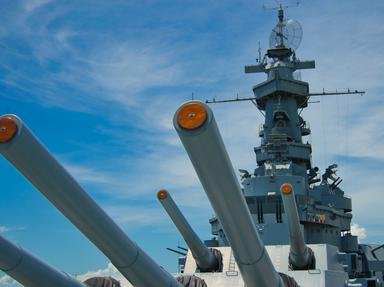Quiz Answer Key and Fun Facts
1. After World War I the battleship was still thought of as a super weapon. The Washington Naval Treaty of 1922 was established to limit the size and power of these vessels. What were two of the major constrains?
2. Why did the Washington Naval Treaty of 1922 fail to limit the size of battleships in the Second World War?
3. When the Iowa Class battleships were first conceived there was a debate between speed and armament. The designers could offer a vessel with twelve 16 inch guns but the speed would be limited to 27 knots. If the armament was limited to nine 16 inch guns the speed could be extended to over 30 knots. Who finally settled the debate?
4. During the Second World War the industrial might of the United State produced a vast and powerful array of military equipment on an amazing schedule. How long did it take to build an Iowa Class battleship, from keel laid to operation?
5. The Iowa was the first of the class to put to sea. After a brief span escorting North Atlantic conveys she served a vital mission carrying President Roosevelt to the war planning conferences at Cairo and Tehran. What occurred during this voyage to put the President in peril?
6. The sixteen inch guns on the Iowa Class battleships were not the largest cannons ever built but very impressive all the same. What was the range of these mighty guns?
7. The Iowa Class battleships were conceived as the match to the great warships of other maritime powers, especially Japan. What was the result of the ultimate match up of great battleship to battleship conflicts?
8. After the Second World War the Iowa Class battleships were recalled to duty several times, including Korea, Vietnam, Lebanon, and the 1991 Gulf War. During all their service what was the greatest damage any of the class took?
9. Originally conceived as a super weapon the Iowa Class battleships could not hold that place in the post Second World War nuclear age. What nuclear role was given to these great vessels?
10. A serious concern for modern naval engagements is the development and deployment of advanced anti-ship missiles. During the Falklands war the British HMS Sheffield was sunk by a single French Exocet missile fired by an Argentinian aircraft. During the first Gulf war the Iraqi defenses included the much feared Chinese Silkworm anti-ship missiles. What was the result of their use against our Iowa Class battleships?
Source: Author
MicjealS
This quiz was reviewed by FunTrivia editor
bloomsby before going online.
Any errors found in FunTrivia content are routinely corrected through our feedback system.

